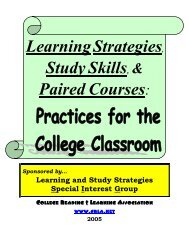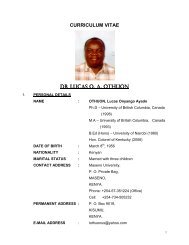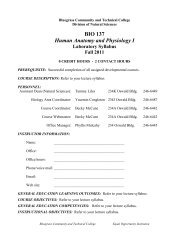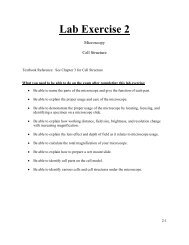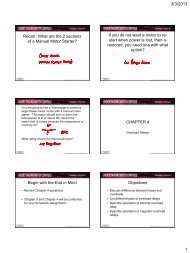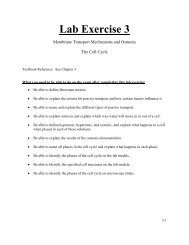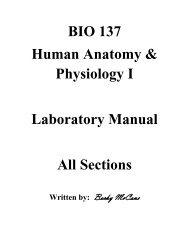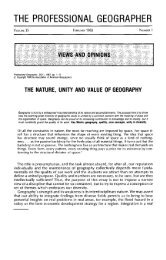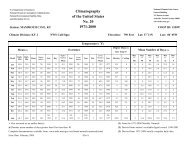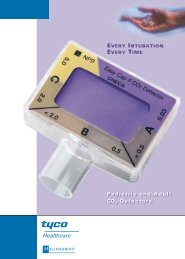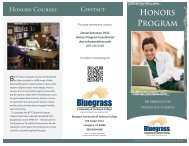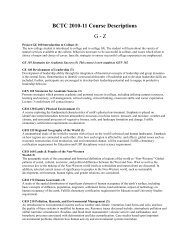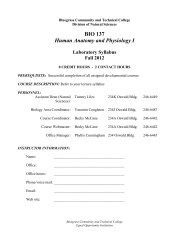Skeletal Muscle Identification and Function
Skeletal Muscle Identification and Function
Skeletal Muscle Identification and Function
You also want an ePaper? Increase the reach of your titles
YUMPU automatically turns print PDFs into web optimized ePapers that Google loves.
Bio 137 — Human Anatomy & Physiology I<br />
<strong>Skeletal</strong> <strong>Muscle</strong> <strong>Identification</strong> <strong>and</strong> <strong>Function</strong><br />
Students will be expected to identify the following muscles <strong>and</strong> their functions<br />
on the head, arm, leg <strong>and</strong> muscle man models.<br />
Body Region<br />
<strong>Muscle</strong> <strong>Function</strong>s<br />
Head <strong>and</strong> Neck — Head muscle model <strong>and</strong> muscle man model (Table 14.1, Fig 14.3)*<br />
Frontalis Raises eyebrows <strong>and</strong> wrinkles forehead<br />
Orbicularis oculi Closes eye<br />
Orbicularis oris Closes lips; kissing <strong>and</strong> whistling<br />
Sternocleidomastoid Flexes, tilts, <strong>and</strong> rotates head<br />
Zygomaticus Raises corners of mouth; smiling<br />
Masseter Elevates (closes) <strong>and</strong> protracts jaw, as when chewing<br />
Torso — <strong>Muscle</strong> man model (Table 15.1, Figs 12.1, 15.1, 15.3, 15.4)*<br />
Trapezius Shrug shoulders<br />
Latissimus dorsi Extends, adducts <strong>and</strong> medially rotates arm<br />
Pectoralis major Flexes, adducts <strong>and</strong> medially rotates arm<br />
External oblique Lateral rotation of the vertebral column, twisting<br />
Rectus abdominis Flexion of the vertebral column; sit ups<br />
Upper Limb — Arm muscle model (Table 12.1, Figs 12.1, 12.6, 12.7, 12.12)*<br />
Deltoid † Abducts, flexes, <strong>and</strong> rotates arm<br />
Triceps brachii † Extends forearm <strong>and</strong> arm<br />
Biceps brachii † Flexes forearm<br />
Brachioradialis Flexes forearm<br />
Extensor digitorum Extends fingers <strong>and</strong> h<strong>and</strong><br />
Extensor carpi radialis longus Extends h<strong>and</strong><br />
Flexor carpi ulnaris Flexes h<strong>and</strong><br />
Palmaris longus Flexes h<strong>and</strong><br />
† <strong>Muscle</strong> should be identified on the muscle man model in addition to the arm model
Bio 137 — Human Anatomy & Physiology I<br />
<strong>Muscle</strong> <strong>Function</strong>s<br />
Lower Limb — Leg muscle model <strong>and</strong> muscle man model (Table 13.1, Figs 12.1, 13.1-13.7)*<br />
Tensor fasciae latae Flexes, abducts <strong>and</strong> rotates thigh<br />
Adductor longus Adducts, flexes, <strong>and</strong> rotates thigh<br />
Gluteus maximus Extends, abducts <strong>and</strong> rotates thigh<br />
Gracilis Adducts thigh <strong>and</strong> flexes leg<br />
Sartorius Crosses the leg<br />
Vastus medialis Extends leg<br />
Vastus lateralis Extends leg<br />
Biceps femoris Extends the thigh <strong>and</strong> flexes leg<br />
Rectus femoris Flexes thigh <strong>and</strong> extends leg<br />
Tibialis anterior Dorsiflexion of the foot<br />
Fibularis (peroneus) longus Plantar flexion of the foot<br />
Gastrocnemius Plantar flexion of the foot<br />
* References are for Eric Wise, Laboratory Manual for Anatomy & Physiology (Exercises 12-15;<br />
pp 155-226). For additional information, students should also refer to the following sources:<br />
Elaine Marieb, Human Anatomy & Physiology (lecture text) — Chapter 10<br />
A Brief Atlas of the Human Body — Figs 62-65, 67-70.



